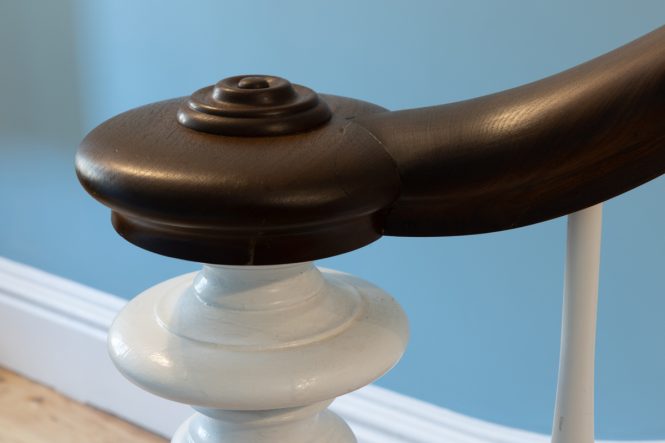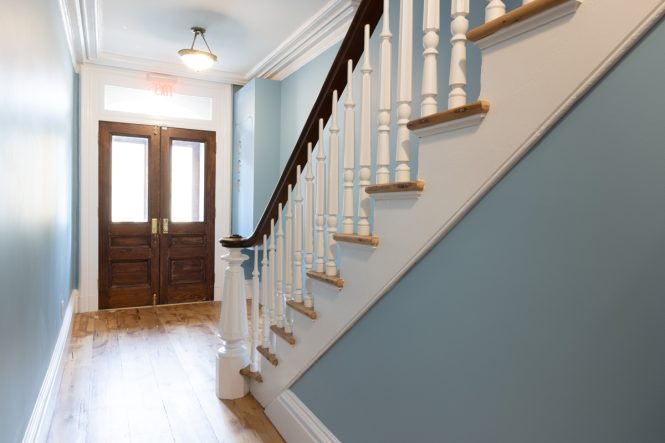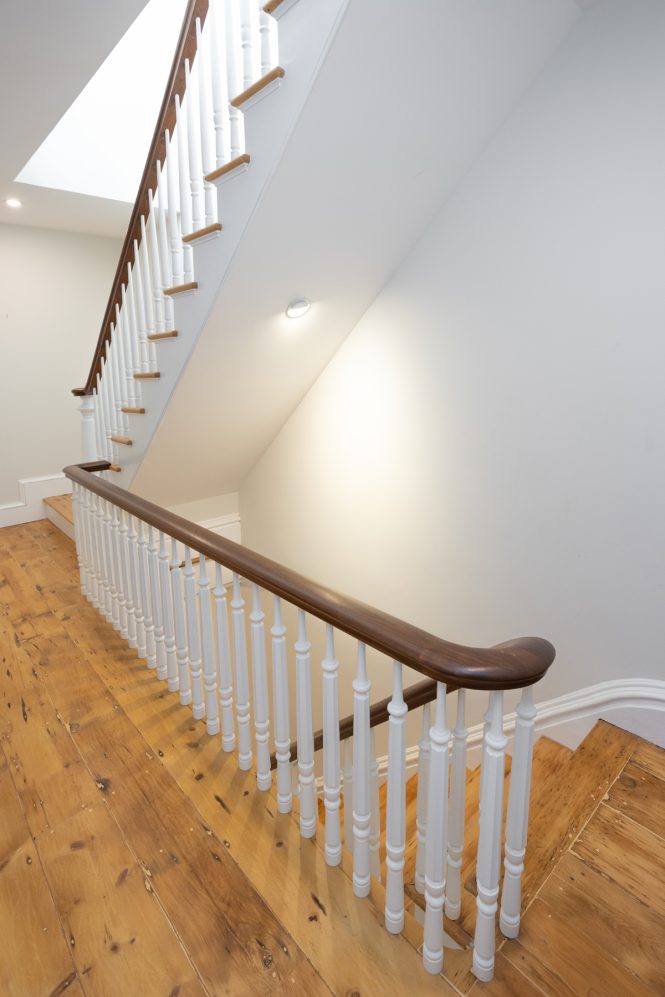Steps Through Time: A Newburgh Staircase Restoration
By Lisa Iannucci | Summer 2023 | Design Feature
The next time you look at your staircase, consider its history. Peter Moffa, a woodworker in Shokan, says he thinks about it on every renovation job he takes on. “Staircases have all the history,” he says. “The marks where it has been worn down—how many people did it take to do that? How many stories are there? If your house is old, what about the carpenters or woodworkers who worked on that staircase and the tools they used, bringing blocks of wood and making those stairs happen by hand? It’s pretty complex, and everything fits together so beautifully.”
Moffa especially sees that beauty in his most recent project in Newburgh, which started before the pandemic, when he was contacted by architect Jeff Wilkinson. “There’s something magical about staircases and handrails and the more I see, the more I am amazed at their art form and how exquisite they are,” says Moffa, who became interested in woodturning when he was in his 20s. He watched a friend do it and asked to learn how to shape or “turn” wood on a lathe into decorative elements, such as stair spindles and porch posts.

Before and after photos of the staircase restoration woodworker Peter Moffa recently completed in a Newburgh townhouse.
After learning about woodturning, Moffa moved to California, where he spent a few years before returning to the Hudson Valley. He fell in love with architecture here, especially in Newburgh. About 15 years ago, Moffa attended a trade event where he learned about stair building, which was the catalyst for his interest in the craft.
Moffa started his woodworking business when he was 26. He has since learned CAD drafting and modeling, allowing him to use the computer to determine the complexity of his projects and see their parts. “I also have a router that’s computer controlled, so it can carve complex pieces that I can model in the computer, including handrail fittings,” Moffa says.
Now 54, Moffa has more than 30 years of woodworking experience and enjoys the mix of working in his shop as well as on job sites. “I enjoy giving a homeowner something beautiful that they use daily,” he says.

Photo by Lori Adams
One Step at a Time
When he arrived at the Newburgh site, he discovered that the top stair was heavily damaged due to rain getting in due to roof rot. “The freeze/thaw of water does a lot of damage to wood over time, and much of the top stair needed to be rebuilt because of rot and missing parts,” he says.

Photo by Lori Adams
Moffa says that, over the decades, the house had been divided into separate dwellings, and, as a result, large sections of balconies had disappeared and walls put up in their places. “The handrails and newels were wobbly, and many spindles were missing or replaced with cheap ones from the home center,” he says. “The floor underneath the bottom stair had rotted away, and so the open side of the stair had sunk downward two inches.”
Many attempts at repairs to the stairs had been made through the years with drywall screws and various-sized nails, but the stairs needed a great deal of attention to make them solid again.
While working on older homes, such as the Newburgh project, Moffa turns pieces, replaces missing parts, and reinforces others. “New wood is beautiful in itself, but there’s something about old wood, its growth and character from the marks and scratches. I put a nice finish on it and the old wood really pops.”

Photo by Lori Adams
He also patched and carved various handrail fittings where they had been broken or missing due to neglect, and turned missing parts of newel posts and newel caps. “I built new treads where the original ones were missing.”
Moffa says he dislikes seeing staircases poorly repaired or, even worse, ripped out and replaced with something tacky because it’s not cheap to save an old staircase.
“Older staircases are originally done by a master craftsman who knew how to make things beautiful,” he says. “I don’t even know how to improve on that beauty, but it’s an honor to work on them.”
Sometimes, Moffa says, homeowners incorporate pieces they got from architectural salvage places that match the period of the house. “For this Newburgh project, my customer found a newel post at a New Hampshire salvage place, and it brings a beautiful, octagonal element to the staircase,” says Moffa. “He brings his friends over, and they don’t believe it hasn’t always been there.”

Photo by Lori Adams
If a project requires a few new spindles, Moffa will turn them by hand. If it requires many spindles, a company with automated machines completes the task. “I then go in there and sharpen up the details of the turnings a little bit by hand,” he says.
Restoration as Archeology
The Newburgh project began before the pandemic hit and took an on-and-off period of two years to complete. “There were many months that I waited for other trades to do their part because we weren’t allowed to work together,” he says.
Woodworking is a craft that Moffa recognizes has changed over the years. “There’s great beauty in how it’s all evolving,” he explains. “The quality of woodworking tools today can do amazing things more precisely. But you still need someone like me to figure out what needs to be done, how to patch things together, and how to make things work. There’s plenty of work to be done, and it takes persistence and dedication. I’ve dealt with fixing old staircases where somebody went in there with drywall screws or bolts and made things worse.”
Moffa compares working on stairs to archeology. “When you’re working on a project like this, things start to reveal themselves, and you get a sense of what might have happened at different periods of time in the state and how people dealt with things and how much money or resources they had. It also tells me if they had the ability to fix things. Now I’ve learned that these older homes are beautiful and timeless and the staircases are their fingerprint.”
